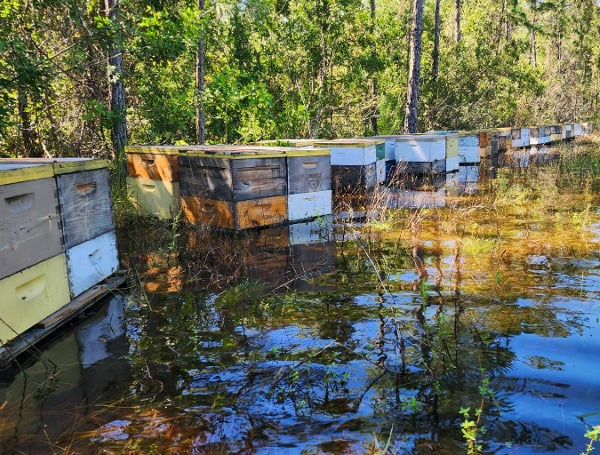Honey bees not only create an agricultural product, they help facilitate the Florida agriculture industry, pollinating crops and bolstering our food supply.
When Hurricane Ian made landfall last week, many of the local colonies were devastated, said Amy Vu, a statewide apiculture Extension specialist with the UF/IFAS Honey Bee Research and Extension Laboratory. But it was more than Florida-based colonies in the storm’s path. Some out-of-state beekeepers had already moved their colonies into Florida, where they often overwinter while the foraging sources remain abundant.
Florida’s 5,000 registered beekeepers manage about 700,000 colonies, according to the Florida Department of Agriculture and Consumer Services. This number does not include out-of-state beekeepers who migrate their bees. The Sunshine State is the fourth-largest honey producer in the nation, according to the U.S. Department of Agriculture.
Below, Vu addresses some of the most commonly asked questions she’s received since the storm passed.
Q: What are you hearing from beekeepers about how they fared in Hurricane Ian?
A: Many beekeepers, especially in the southwest part of Florida, have lost a significant part of their operation. This might mean not only a loss of honey bee colonies, but also lost equipment, as well as vital infrastructure, such as honey houses and equipment storage units.
Q: How many beekeepers or colonies have been impacted?
A: It’s too early to tell. We will know in the next few weeks or months, once beekeepers are able to access their colonies and assess colony health. Thousands of colonies are currently underwater. Between the hurricane’s route from the southwest coast to the northeast coast, an estimated 380,000 colonies are located, not including out-of-state beekeepers.
Q: What does flooding do to bees and pollination?
A: If a hive is completely submerged in floodwater, all the bees in it will die, and the equipment – such as the frames, hive bodies, and even the honeycomb – can be damaged or destroyed. If floodwaters are high enough to block the entrance of a beehive, the bees cannot escape, and this can also lead to the colony drowning.
For pollination after a natural disaster like this, many hives are lost or weakened; thus there may be fewer bees to fill pollination contracts. Ultimately, this could impact our food chain.
Q: How do beekeepers prepare for storms?
A: Many times, colonies are lost to flooding, so it is best for beekeepers to get their colonies to high ground. If they might be facing major winds, strapping the colonies together so their lids and equipment don’t blow apart is also recommended.
Q: For the bees that survived the storm, are they struggling to find resources?
A: Many of the colonies that were hit by the storm and survived could be weakened by days of no forage availability. High winds and rain can cause flowers to be blown off the plants, if the plants are not destroyed completely. Not only do these bees suffer from a lack of forage availability, they may face pests and diseases that will try to cause more damage overall.
Q: What is being done to help honey bees survive?
A: The first step to assessing apiaries is to open hive lids to check for damage and move colonies to dry ground if possible. If beekeepers can access their apiaries, they can feed their bees a sugar syrup to make up for the lost forage.
During Hurricane Michael recovery, beekeepers in the Florida Panhandle used open feeding, which means they put sugar water or syrup out in the open for any bee – not just the honey bees, but wild bees, as well – to collect it. For inaccessible areas, flying drones overhead can help to figure out colony locations and determine feed placement. Honey bees can fly up to a 5-mile radius.
Q: What can be done for beekeepers?
A: The Florida State Beekeepers Association, Florida Department of Agriculture and Consumer Services, Florida Farm Bureau, UF/IFAS Honey Bee Research and Extension Laboratory and industry members are all collaborating to help provide relief efforts where possible. This includes immediate aid in the form of monetary support as well as food, equipment and bees.
UF/IFAS has been helping to facilitate communication – a task made more challenging given telecommunications outages post-storm – between beekeepers, government and funding agencies, insurance companies, and more. One major UF/IFAS task after hurricanes is to collect information for an agricultural assessment survey that examines any agricultural losses and damages resulting from Hurricane Ian. This information will be used to educate donor organizations and entities to help solicit aid.
Visit Tampafp.com for Politics, Sports, and National Headlines. Support journalism by clicking here to our GiveSendGo or sign up for our free newsletter by clicking here.
Android Users, Click Here To Download The Free Press App And Never Miss A Story. Follow Us On Facebook Here Or Twitter Here.
Copyright 2022 The Free Press, LLC, tampafp.com. All rights reserved. This material may not be published, broadcast, rewritten, or redistributed.

